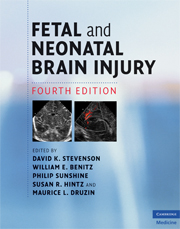Book contents
- Frontmatter
- Contents
- List of contributors
- Foreword
- Preface
- Section 1 Epidemiology, pathophysiology, and pathogenesis of fetal and neonatal brain injury
- Section 2 Pregnancy, labor, and delivery complications causing brain injury
- 5 Prematurity and complications of labor and delivery
- 6 Risks and complications of multiple gestations
- 7 Intrauterine growth restriction
- 8 Maternal diseases that affect fetal development
- 9 Obstetrical conditions and practices that affect the fetus and newborn
- 10 Fetal and neonatal injury as a consequence of maternal substance abuse
- 11 Hypertensive disorders of pregnancy
- 12 Complications of labor and delivery
- 13 Fetal response to asphyxia
- 14 Antepartum evaluation of fetal well-being
- 15 Intrapartum evaluation of the fetus
- Section 3 Diagnosis of the infant with brain injury
- Section 4 Specific conditions associated with fetal and neonatal brain injury
- Section 5 Management of the depressed or neurologically dysfunctional neonate
- Section 6 Assessing outcome of the brain-injured infant
- Index
- Plate section
- References
13 - Fetal response to asphyxia
from Section 2 - Pregnancy, labor, and delivery complications causing brain injury
Published online by Cambridge University Press: 12 January 2010
- Frontmatter
- Contents
- List of contributors
- Foreword
- Preface
- Section 1 Epidemiology, pathophysiology, and pathogenesis of fetal and neonatal brain injury
- Section 2 Pregnancy, labor, and delivery complications causing brain injury
- 5 Prematurity and complications of labor and delivery
- 6 Risks and complications of multiple gestations
- 7 Intrauterine growth restriction
- 8 Maternal diseases that affect fetal development
- 9 Obstetrical conditions and practices that affect the fetus and newborn
- 10 Fetal and neonatal injury as a consequence of maternal substance abuse
- 11 Hypertensive disorders of pregnancy
- 12 Complications of labor and delivery
- 13 Fetal response to asphyxia
- 14 Antepartum evaluation of fetal well-being
- 15 Intrapartum evaluation of the fetus
- Section 3 Diagnosis of the infant with brain injury
- Section 4 Specific conditions associated with fetal and neonatal brain injury
- Section 5 Management of the depressed or neurologically dysfunctional neonate
- Section 6 Assessing outcome of the brain-injured infant
- Index
- Plate section
- References
Summary
Introduction
For most of the twentieth century the concept of perinatal brain damage centered around cerebral palsy and intrapartum asphyxia. It is only in the last 20 years that this view has been seriously challenged by clinical and epidemiological studies that have demonstrated that approximately 70–90% or more of cerebral palsy is unrelated to intrapartum events. Many term infants who subsequently develop cerebral palsy are believed to have sustained asphyxial events in mid-gestation. In some cases, prenatal injury may lead to chronically abnormal heart-rate tracings and impaired ability to adapt to labor, which may be confounded with an acute event.
Furthermore, it has become clear that the various abnormal fetal heart-rate (FHR) patterns that have been proposed to be markers for potentially injurious asphyxia are consistently only very weakly predictive for cerebral palsy. Although metabolic acidosis is more strongly associated with outcome, more than half of babies born with severe acidosis (base deficit > 16 mmol/L and pH < 7.0) do not develop encephalopathy, while conversely encephalopathy can still occur, although at low frequency, in association with relatively modest acidosis (BD 12–16 mmol/L). These data contrast with the presence of very abnormal fetal heart-rate tracings, severe metabolic acidosis, and acute cerebral lesions in the great majority of infants who do develop acute neonatal encephalopathy.
The key factor underlying all of these observations is the effectiveness of fetal adaptation to asphyxia.
- Type
- Chapter
- Information
- Fetal and Neonatal Brain Injury , pp. 143 - 162Publisher: Cambridge University PressPrint publication year: 2009
References
- 2
- Cited by



